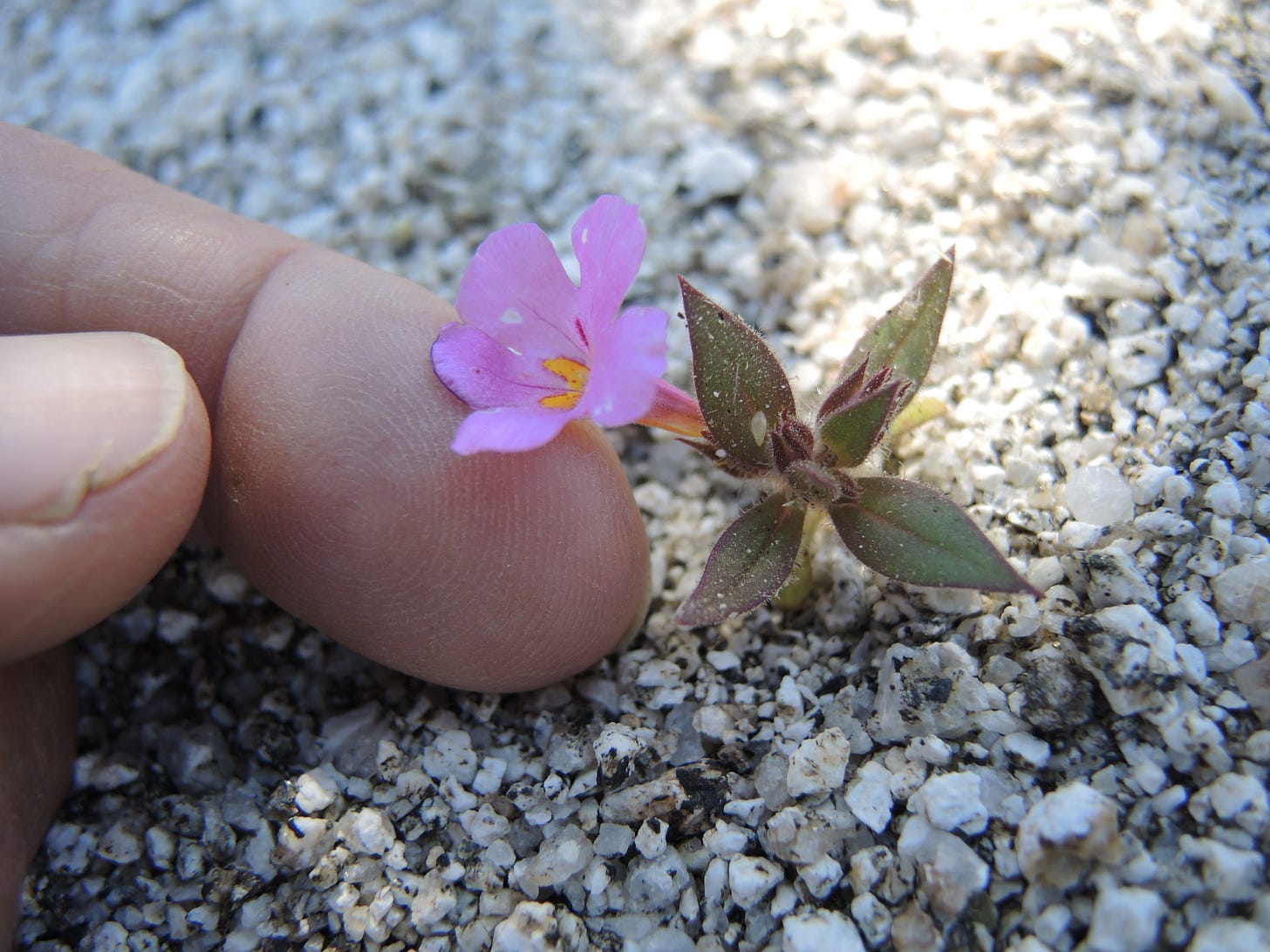I have trouble imagining why someone would name a canyon Flatcat Canyon, but the percussive name and the image it conjures up made me resolve to explore it one fine spring day. Copious winter rains have turned the desert into a huge flower bed, and the gravelly wash of lower Flat Cat Canyon is no exception. The gravelly granite sand crunches nicely with each step, a rhythmic ratchet sound like a guiro in a Cuban band. The desert lavender swarms with bees, hummingbird males do their show-off, whistling cartwheels overhead and the yellow, purple and blue of desert annuals colors the wash ahead. Crowds of purple Phacelia unfurl their flowering stalks to present their flowers one by one, and tiny monkey flowers (Mimulus) whose entire being would hardly cover a child's little fingernail, are so abundant that the ground blushes violet, accented here and there with the contrasting yellow of an equally tiny composite.
To look upon the annuals in this wash, is to ponder life's capriciousness, for their size, including Phacelia's, varies from tiny single-stemmed, single flowered dwarfs to multi-branched giants (relatively) blooming luxuriously. Luck plays its tricks at every stage--- which particular genes have found their way into the ovule during meiosis, which genes were delivered to the ovule in the pollen nucleus, not to mention the luck of having an insect provide pollen at all. Then comes the luck of escaping being a caterpillar's lunch or a bruchid's dinner, followed by the luck of exactly where the seed falls to ground. And here luck is multiplied by luck, for particular combinations of genes from both the ovule and the pollen suit the seed better for some kinds of ground rather than others, and this is multiplied again by the luck of a rainstorm at just the right time. So luck multiplied again and again by luck means that some plants grow to large size and others remain stunted or even die. The unfairness of this is that, as in human society, affluence is heritable, and luck echoes down to the next generation and beyond, for large plants are attractive to pollinators and produce lots of seeds and many offspring in the next generation, and small plants do not. Is it possible to reverse one’s fortunes, whether human or plant? I suppose so. Moreover, by definition luck is capricious, and attributes that are lucky one year may be unlucky the next. The luck of plants, like the luck of humans can propel them into affluence, or sink them into poverty, but the luck of the affluent beats the luck of the poor most of the time.
As I make my way up Flat Cat Wash the walls close in and the stream bed begins to rise steeply, becoming a scramble over boulders with ponds of sand behind them. In a seep near the top of the canyon, just below an impassable rockfall, grows a grove of native fan palm, Washingtonia filifera, a grove that is rarely visited by either people or fire. Reduced neither by decay nor fire, the fallen fronds have been accumulating for decades, and form a thick floor dense enough to walk on (with care), suspended 6 feet above the ground on the tops of hapless, struggling bushes.

Here too, life's capriciousness reigns, for this grove was established by a few of the millions of seeds produced by fan palms of the region, seeds delivered by some bird, and falling on this rare permanent seep at just the right time. Just as the grove's birth was capricious, so will be its future demise when, just by chance, fire reaches it and the accumulated dead fronds explode into a roaring, lethal blaze. But then, the offspring of the sacrificed palms will have a larger draw of luck, for their seeds will be in the right spot to create the palm grove again. No matter how you slice it, you need luck in life.





I greatly enjoyed this piece. It revived happy memories of treks in Borrego. I can hear the crunch of footsteps and sniff clean herbal aromas. So much to experience. Thanks for conjuring up the image of dessert life as intricate beauty and a game of chance.
Again, thank you for these musings. I always appreciate the detail and thoughtfulness that go into them.